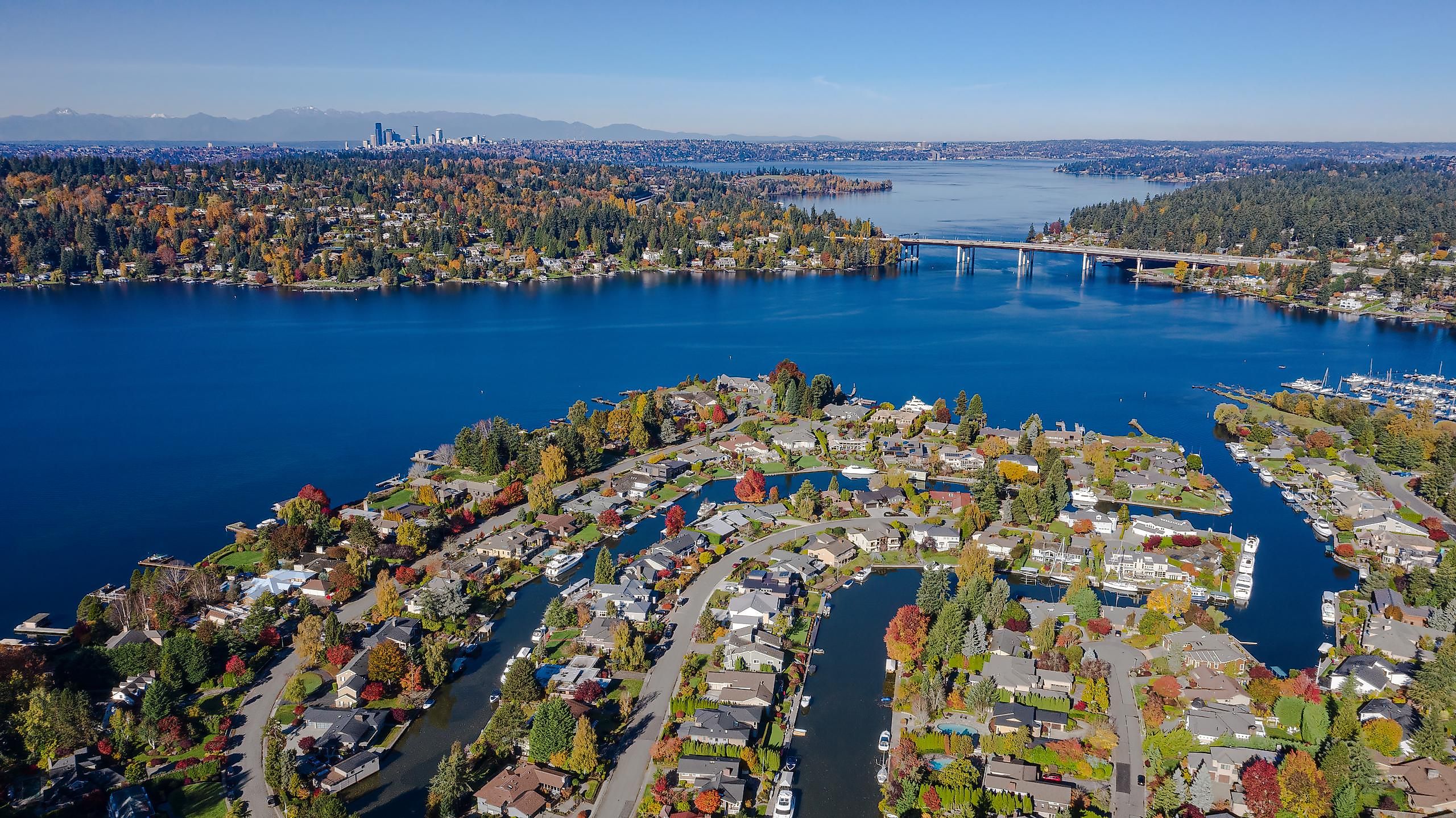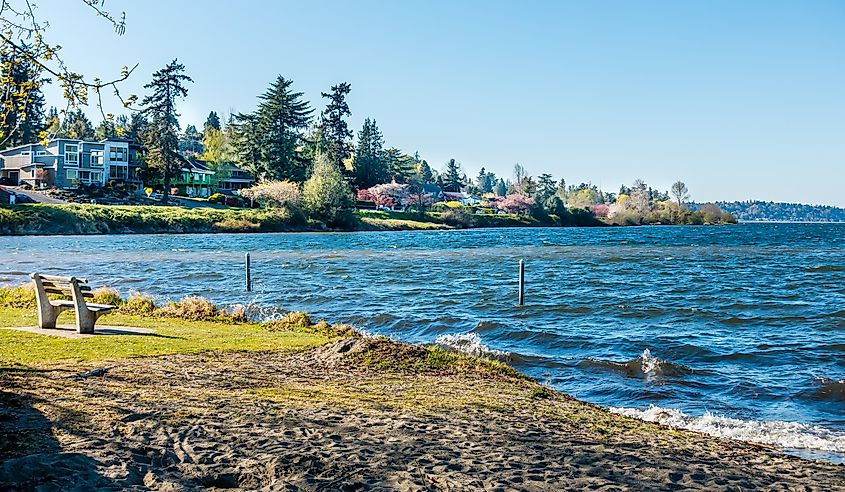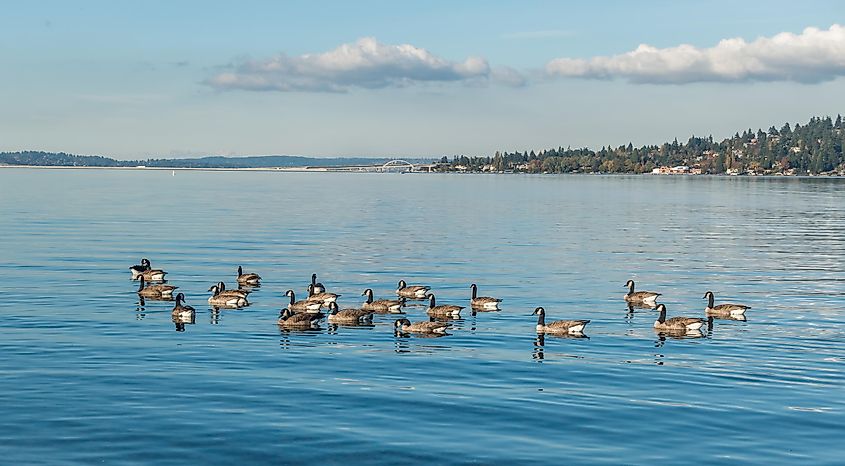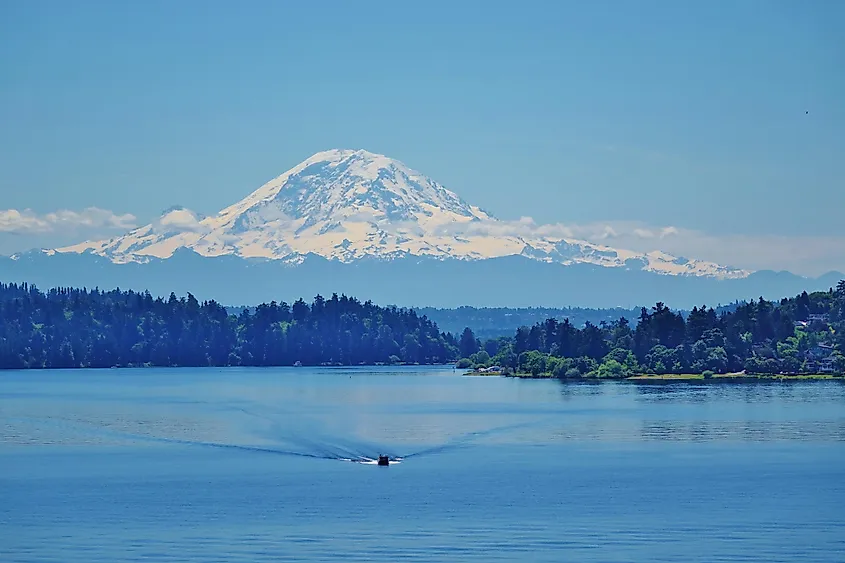
Lake Washington
Lake Washington is located in King County and is the second-largest natural lake in the state of Washington. The lake borders the city of Seattle and is a popular recreational area in the region. There are annual hydroplane races, cruises, and many other recreational activities all along the lake and its shores. Swimming, kayaking, and boating are available at multiple locations. There are access points to the lake at the Atlantic City Boat Ramp, Saint Edward State Park, Seward Park, Stan Sayres Memorial Park, and Warren G. Magnuson Park. The lake was named after George Washington in 1854.
Geography Of Lake Washington

Seattle borders the lake to the west, and about 32 km of the lake's shoreline is within city limits. Lake Washington connects to Puget Sound through Lake Union and the Lake Washington Ship Canal, which was built in 1916. The Ship Canal uses a system of locks and a dam to release the waters from Lake Washington.
The main tributaries to Lake Washington are Cedar River, which enters the lake at the south end, and the Sammamish River, which essentially drains Sammamish Lake and enters Lake Washington from the north. Other tributaries include Coal Creek, Fairweather Creek, Forbes Creek, and several other freshwater creeks. The Lake belongs to the Cedar River-Lake Washington Watershed. The upper waters of Cedar River are protected as part of the Seattle area water supply.
Geology
The region was subject to much upheaval in prehistoric times due to the Juan de Fuca tectonic plate. The pressures created the Olympic and Cascade Mountains. The lake was created by the Vashon Glaciation, which lasted from about 19,000 to 16,000 BP. The retreating ice carved out a deep and narrow trough shape into the layers of bedrock, with sides that slope upwards at a steep angle. The lake is approximately 32 km long, with an average width of just under 2.5 km and a surface area of just under 9,000 hectares. Mercer Island is situated at the lake's southern end, with 48 km of its own shoreline. The Sammamish and Cedar rivers wash phosphorous into the lake's waters.
Climate
The climate of the Lake Washington region is Mediterranean according to the Koppen classification. Summers are mild, and winters are cool. The warmest months of the year are July and August, with average highs of 25 °C. The coldest month of the year is December, with average highs of 8 °C. Winter is the wetter season, with overcast skies much of the time. The wettest month is November, with 16.7 days when there is 1 mm of precipitation or more. In January, the skies are cloudy about 70% of the time, on average.
Conversely, in August, the skies are clear about 70% of the time, with only about 3.5 days when there is 1 mm or more rain. Summer (from June to September) is the driest season. From July to August, the lake's waters reach a mean temperature of about 21 °C.
Flora And Fauna Of Lake Washington

Many species of fish make their homes in the lake, including many sought-after game species, including coastal cutthroat trout, largemouth and smallmouth bass, yellow perch, and black crappie. Chinook, coho, and sockeye salmon return each spawning season. The lake is open for fishing year-round. However, there are several zone-fishing closures in the area of the floating bridges. Minimum size requirements also apply to protect the young fish in the spring after they spawn, including steelhead trout.
There are access ramps to the lake for fishing at Kenmore, Magnuson Park at Sand Point, Gene Coulon Park in Renton, and Rainier Beach Park in Rainier Beach. The banks are accessible in many areas, and many fishing piers extend into the lake, including some public ones.
The forests around the lake consist largely of fir, cedar and pine trees, which are home to many different species of animals. These include deer, elk, bears, cougars, and mountain goats in higher elevations. Many species of waterfowl live in the area and migrate seasonally along the lake to Puget Sound Lowland.
Brief History Of Lake Washington

The Duwamish Native Americans lived in the area of Lake Union for more than 5,000 years before the arrival of European settlers. Their name for Lake Union compared it to Lake Washington; in the Lushootseed language, it was called Ha-AH-Chu or "littlest lake ."The people who lived along the shores of Lake Washington were known as hah-choo-AHBSH, or "people of the large lake ."The Duwamish lived in longhouses, hunted the abundant game in the forests, and fished in the waters of both lakes.
European settlers first arrived in the area in 1851, when Seattle was founded as a townsite called New York. After the construction of a link to the Northern Pacific Railway in 1883, the area's population began to skyrocket.
The completion of the Canal resulted in the Black River's draining and the diversion of Cedar River into Lake Washington. Prior to 1912, Cedar River drained into the Black River, which in turn drained into Lake Washington at its southern end. A severe flood in 1911 spurred the building of the Canal, which diverted the river into Lake Washington. The Canal also connects Lake Washington and Lake Union. Before the construction of the Ship Canal, there was no outflow from the lake. Since 1916 and the Canal's construction, the lake's level has lowered by about 2.75 m.
A system of ferries was established to take passengers across the lake, which operated from the 1880s until 1950. The lake is 65 m deep (at its deepest), with a muddy bottom. It prevents the construction of many types of bridges, hence the use of floating bridges built on concrete pontoons. These include the Evergreen Point Floating Bridge, the world's longest floating bridge; the second longest, the Lacey V. Murrow Memorial Bridge; and the Third Lake Washington Bridge, the world's fifth longest.
After years of urbanization and the resulting pollution and toxic drainage into the lake, a concerted effort during the 1960s diverted sewage and restored the lake's water, as well as its populations of fish and other animals. Today, Lake Washington is a beautiful destination to visit with family and friends to enjoy the wide range of activities it has to offer.











